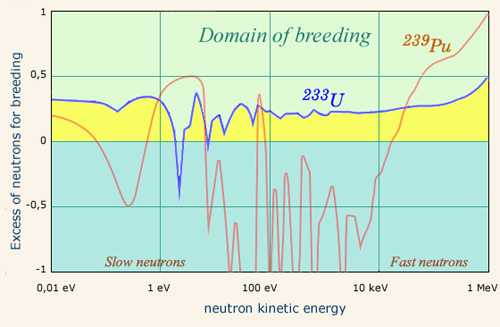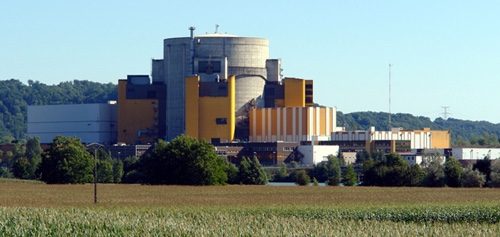A motor producing more fuel than it consumes …
Ordinary motors need to be filled with fuel to produce energy. Nuclear Energy has a remarkable property: some nuclear reactors are designed to produce more fuel than it consumes. This extraordinary technique is known as ‘breeding‘.

Breeding with plutonium 239
For breeding to take place, the balance of fuel regeneration must be positive. This balance varies rapidly with the energy of the neutrons that trigger fissions. For plutonium 239, the feedback is positive for very slow neutrons and mainly for those with energies over 10 keV. This is the reason why plutonium breeder reactors operate with fast neutrons.
© IN2P3 (Source A.Nuttin/LPSC Grenoble).
The nuclear fuel is regenerated by reactions which transform non-fissile nuclei in the fuel into fissile ones. These nuclei are called fertile for that reason. In reactors these fertile nuclei are uranium 238 and thorium 232, the most abundant natural isotopes of their respective elements.
The first regeneration mode under way in uranium reactors in operation today is the transformation of non-fissile uranium 238 into fissile plutonium 239.
The second regeneration scheme has only be tested but never yet been used at an industrial scale. Ii involves the conversion of thorium 232 into fissile uranium 233. This possibility has not been used so far. But there is a draft Generation IV reactor that would use thorium and uranium-233 instead of uranium and plutonium-239.

Breeding with uranium 233:
For breeding to take place, every gram of fissile matter burned up should be replaced by one gram or more of new fissile nuclei in the fuel. In the case of uranium 233 practically all neutron energies meet this condition. Breeders operaring with an thorium-uranium 233 fuel can sustain themselves for the whole range of neutron energy, including slow neutrons..
© IN2P3
Development of breeders based on uranium offers attractive prospects, as they would run on uranium 238 which is 140 times more abundant than the uranium 235 used today. Experts believe that if this transition can be made, the amount of usable nuclear energy available would increase a hundredfold.
Breeding is a technically difficult process. It requires fast neutrons and liquid coolants made of molten lead or sodium, necessary in order to optimize the number of neutrons captured by the fertile uranium.
Mankind has always dreamed of a water powered motor and « breeder » offer a kind of motor powered by an almost inexhaustible fuel ! When resource of nuclear fuel enriched in uranium-235 was scarce, expectations for breeders were high.

The french breeder reactor SUPERPHENIX at Creys-Malville
SUPERPHENIX was a major breeder reactor designed to produce electricity. In 1996, it was decided to abandon the production of electricity, but to use fast neutrons from the reactor to burn plutonium and radioactive waste. This option was abandoned in 1997.
© CEA/ Common Wikipedia
At a time when nuclear fuel enriched in uranium-235 was a scarce resource, expectations were high for this type of reactor. France built an industrial breeder (called SUPERPHENIX) that has produced electricity but was called off in 1997 for more electoral than technical reasons. Then, the development of breeders was more or less stopped in 1997. Hoxever, it can resume with the project ASTRID in a near furure.
In 2010, only a few breeders were in operation. Most of the development has been postponed, in some countries ground to a halt. There are a number of reasons for this: negative public opinions based on fears and technological, economical factors. During many years oil was cheap. Despite the scarcity of fissile uranium 235, there was no urgent need for more resources.
This may change, and future reactors are likely to be breeders in 20-30 years. Russia has now taken the leadd. After the BN-600 reactor at Beloyarsk Power Station, which has been in operation for 30 years, it commissioned a powerful 885 MW (megawatts) reactor in October 2016, the BN-800.